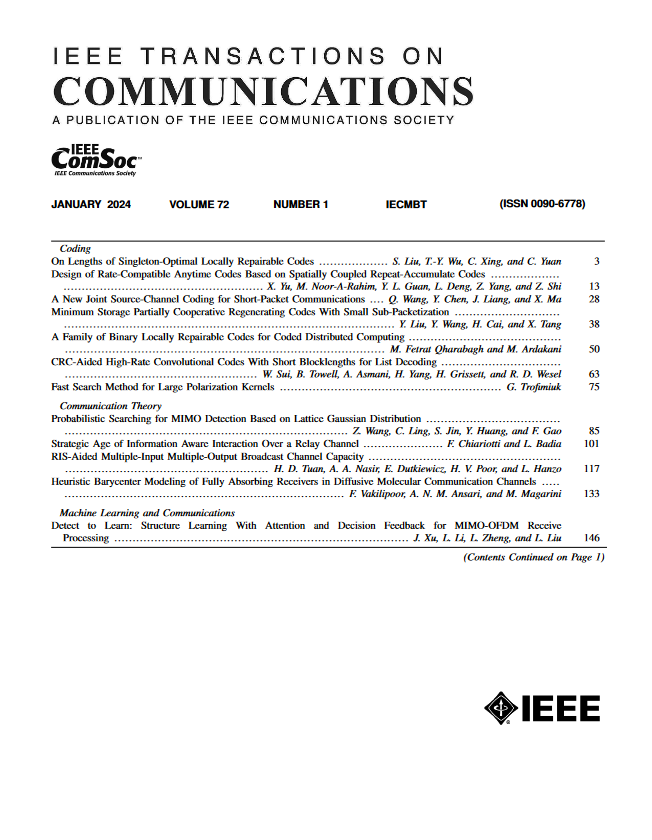通信辅助三维InSAR传感无人机编队与资源分配优化
IF 8.3
2区 计算机科学
Q1 ENGINEERING, ELECTRICAL & ELECTRONIC
引用次数: 0
摘要
本文研究了基于通信辅助三维合成孔径雷达(SAR)传感的联合无人机(UAV)编队和资源分配优化问题。我们考虑了一个由两架无人机组成的系统,它们执行双基地干涉SAR (InSAR)传感,以生成数字高程模型(DEM),并将雷达原始数据实时传输到地面站(GS)。为了满足实际的三维传感需求,我们使用了非传统的传感性能指标,如干涉相干性,即两幅共配准的无人机SAR图像之间的局部互相关、点对点InSAR相对高度误差和模糊高度,这些指标共同表征了InSAR系统确定地面目标高度的精度。我们的目标是共同优化无人机编队、速度和通信功率分配,以最大限度地实现InSAR覆盖,同时满足能量、通信和InSAR特定传感约束。为了解决公式化的非光滑非凸优化问题,我们将其分为三个子问题,并提出了一种基于经典、单调和随机优化技术的新的交替优化框架。通过大量的仿真验证了该算法的有效性,并与几种基准方案进行了比较。此外,我们的模拟结果突出了UAV-GS通信链路对飞行编队和传感性能的影响,并表明可以成功地绘制和卸载大面积感兴趣的DEM,同时可以以厘米尺度精度估计地面地形。最后,我们证明了低无人机速度更适合InSAR应用,因为它可以提高传感精度。本文章由计算机程序翻译,如有差异,请以英文原文为准。
UAV Formation and Resource Allocation Optimization for Communication-Assisted 3D InSAR Sensing
In this paper, we investigate joint unmanned aerial vehicle (UAV) formation and resource allocation optimization for communication-assisted three-dimensional (3D) synthetic aperture radar (SAR) sensing. We consider a system consisting of two UAVs that perform bistatic interferometric SAR (InSAR) sensing for generation of a digital elevation model (DEM) and transmit the radar raw data to a ground station (GS) in real time. To account for practical 3D sensing requirements, we use non-conventional sensing performance metrics, such as the interferometric coherence, i.e., the local cross-correlation between the two co-registered UAV SAR images, the point-to-point InSAR relative height error, and the height of ambiguity, which together characterize the accuracy with which the InSAR system can determine the height of ground targets. Our objective is to jointly optimize the UAV formation, speed, and communication power allocation for maximization of the InSAR coverage while satisfying energy, communication, and InSAR-specific sensing constraints. To solve the formulated non-smooth and non-convex optimization problem, we divide it into three sub-problems and propose a novel alternating optimization (AO) framework that is based on classical, monotonic, and stochastic optimization techniques. The effectiveness of the proposed algorithm is validated through extensive simulations and compared to several benchmark schemes. Furthermore, our simulation results highlight the impact of the UAV-GS communication link on the flying formation and sensing performance and show that the DEM of a large area of interest can be mapped and offloaded to ground successfully, while the ground topography can be estimated with centimeter-scale precision. Lastly, we demonstrate that a low UAV velocity is preferable for InSAR applications as it leads to better sensing accuracy.
求助全文
通过发布文献求助,成功后即可免费获取论文全文。
去求助
来源期刊

IEEE Transactions on Communications
工程技术-电信学
CiteScore
16.10
自引率
8.40%
发文量
528
审稿时长
4.1 months
期刊介绍:
The IEEE Transactions on Communications is dedicated to publishing high-quality manuscripts that showcase advancements in the state-of-the-art of telecommunications. Our scope encompasses all aspects of telecommunications, including telephone, telegraphy, facsimile, and television, facilitated by electromagnetic propagation methods such as radio, wire, aerial, underground, coaxial, and submarine cables, as well as waveguides, communication satellites, and lasers. We cover telecommunications in various settings, including marine, aeronautical, space, and fixed station services, addressing topics such as repeaters, radio relaying, signal storage, regeneration, error detection and correction, multiplexing, carrier techniques, communication switching systems, data communications, and communication theory. Join us in advancing the field of telecommunications through groundbreaking research and innovation.
 求助内容:
求助内容: 应助结果提醒方式:
应助结果提醒方式:


